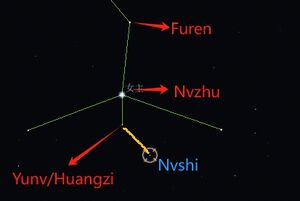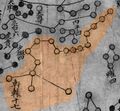Xuanyuan
Xuanyuan
Xuanyuan is the name of the Yellow Emperor. In Chinese astrology, it is a constellation/ asterism symbolizes the body of a yellow dragon. It consists of 17 stars in the area of Leo and Lynx.
Etymology & History of the term
The Yellow Emperor is a legendary figure in China. It is unknown whether or not the "persona" goes back to a real ruler of the country in the 3rd millennium or is completely invented. In the 20th century, this figure was made a symbol for the creator of the state of China and bringer of civilization.
In astrology, it mainly represents the concubines of the Yellow Emperor's harem. Based on the brightness and position of these stars, ancient astrologers named them after different ranks of concubines, mong which the most important is the Nvzhu, representing the emperor's primary wife (the queen), alf Leo. In terms of form, this star also represents the head of the Yellow Dragon, while the stars on the left and right represent its horns (rho, omicron).
Ian Ridpath's webpage on Leo has more information.
Historical Maps
As one of the oldest Chinese constellations, Xuanyuan is depicted on many historical star charts from China.
Lost ones
A weishu book from the western Han Dynasty (1stcentury BCE), titled Xiao Jing · Yuan Shen Qi (孝经·援神契), mentions a kind of Xuanyuan constellation with only 12 stars, compared to the current one with 17 stars. It is possible because the current Xuanyuan constellation includes several very faint stars. Since star maps from that time no longer exist, we cannot determine the specific configuration of these twelve stars. However, according to records, we know that it at least included the prominent/determinative star Nvzhu(Queen, alf Leo), Furen (higher concubine, eta Leo) and Yunv (lower concubine, 31 Leo).[1] This early variant of Xuanyuan should be consistent with the 17-star form regarding the stars in the southern region.
The Huangdi(Yellow emperor)'s Divination is a book that possibly originated during the Han Dynasty. It records a kind of Xuanyuan constellation with also 17 stars, but in its account, Xuanyuan consists of another small star called Nvshi (Female historian, pi Leo) at the south of the Yunv star with a distance of 2 degrees.
Identification of stars
| Star Names or Orders(Traditional/Qing) | Rufus and Tien
Suzhou map[2] |
Ho PENG YOKE[3] | Yi Shitong[4] | Pan Nai[5]
Huangyou (1052) map |
SUN X. & J. Kistemaker[6]
Han Dynasty |
Boshun Yang[7] |
|---|---|---|---|---|---|---|
| Nvzhu (determinative star,1st/14th) | alf Leo | alf Leo | alf Leo | alf Leo | alf Leo | alf Leo |
| Yunv/17th | pi/31 Leo | pi/31 Leo | 31 Leo | 31 Leo | 31 Leo | 31 Leo |
| Shaomin/16th | rho Leo | rho Leo | rho Leo | rho Leo | rho Leo | rho Leo |
| Taimin/15th | omicron Leo | omicron Leo | omicron Leo | omicron Leo | omicron Leo | omicron Leo |
| 2nd/13th | alf Lyn | eta Leo | eta Leo | eta Leo | eta Leo | |
| 3rd/12th | gamma Leo | gamma Leo | gamma Leo | gamma Leo | gamma Leo | |
| 4nd/11th | zeta Leo | zeta Leo | zeta Leo | zeta Leo | zeta Leo | |
| 5rd/10th | mu Leo | mu Leo | mu Leo | mu Leo | mu Leo | |
| 6nd/9th | epsilon Leo | epsilon Leo | epsilon Leo | epsilon Leo | epsilon Leo | |
| 7rd/8th | lambda leo | lambda leo | lambda leo | lambda leo | lambda leo | |
| 8nd/7th | kappa leo | kappa leo | kappa leo | kappa leo | kappa leo | |
| 9rd/6th | f Leo | f Leo | 75 Cnc / f Leo | f Leo | f Leo | |
| 10nd/5th | DR Leo | Hip 47168 | nu Cnc / Hip 47168 | DR Leo | Hip 47168 | |
| 11rd/4th | alf Lyn | alf Lyn | rho2 Cnc / alf Lyn | alf Lyn | alf Lyn | |
| 12nd/3th | 38 Lyn | 38 Lyn | iota Cnc A / 38 Lyn | 38 Lyn | 38 Lyn | |
| 13rd/2th | Hip 44700 | Hip 44700 | 46 Cnc / Hip 44700 | Hip 44700 | Hip 44700 | |
| 14nd/1th | 10 UMa | 10 UMa | 4 LMi / 10 UMa | 10 UMa | 10 UMa |
The numbering of stars has undergone changes. The numbering system popular today is developed by missionaries in the Qing Dynasty, starting from the northernmost star (10 UMa) of the Xuanyuan constellation for coding, which is contrary to the traditional Chinese practice, which should be counted northwards fron the determinative star (from 1 to 14, while the rest 3 stars at the southernmost were already named).
Preserved Images
constellation Xuanyuan on the Suzhou Star Chart (retrieved from https://www.chinesehsc.org/zoomify/suzhou_planisphere.html)
Star Name Discussion (IAU)
Europeans in the IAU WGSN proposed in 2023/4 to use the name "Xuanyuan" for any star in this area, for instance, apply it to the star "alf Lyn" in the IAU-Catalog of Star Names (CSN).
The Chinese members of IAU WGSN considered "Xuanyuan" too important in Chinese Culture and refused to apply this name to any other than the determinative star. Hence, the only proper star for this name would be alpha Leonis which is already named "Regulus". Therefore, the IAU WGSN decided to not use "Xuanyuan" as a name of any stars.
References
- ↑ Yasui Kōzan 安居香山,Nakamura Shōhachi 中村璋八,Weishu jicheng 纬书集成. Hebei Renmin Chubanshe河北人民出版社,1994,p958.
- ↑ Rufus. W. C., Hsing-chin Tien. The Soochow Astronomical Chart. Ann Arbor: University of Michegan Press. 1945, Pp23-24.
- ↑ P.-Y. Ho, “Ancient And Mediaeval Observations of Comets and Novae in Chinese Sources,” Vistas in Astronomy, 5(1962), 127-225.
- ↑ Yi Shitong伊世同. Zhongxi Duizhao Hengxing Tubiao中西对照恒星图表1950. Beijing: Science Press.1981: 116-117.
- ↑ Pan Nai潘鼐. Zhongguo Hengxing Guance shi中国恒星观测史[M]. Shanghai: Xuelin Pree. 1989. p222.
- ↑ Sun Xiaochun. & Kistemaker J. The Chinese sky during the Han[M]. Leiden: Brill. 1997, Pp241-6.
- ↑ B.-S. Yang杨伯顺, Zhongguo Chuantong Hengxing Guance Jingdu ji Xingguan Yanbian Yanjiu 中国传统恒星观测精度及星官演变研究 (A Research on the Accuracy of Chinese Traditional Star Observation and the Evolution of Constellations), PhD thesis, (Hefei: University of Science and Technology of China, 2023). 292.








